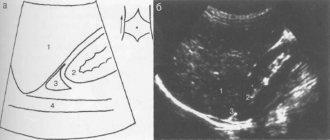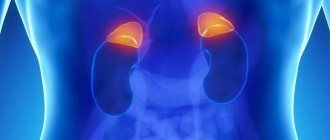At the upper poles of the kidneys there are organs called adrenal glands, or adrenal glands. Being small in size (each of them weighs only 5 - 6 grams), they play a significant role in the hormonal regulation of the body and represent an important component of the endocrine system.
The outer layer of the adrenal gland is called the cortex. It produces sex hormones and corticosteroids (for example, cortisol - the “stress hormone”), which are involved in the regulation of metabolic processes.
The inner part is called the medulla. Catecholamines are produced here. These are adrenaline (“fear hormone”), norepinephrine (“rage hormone”), dopamine (“pleasure hormone”). Catecholamines serve as neurotransmitters, without which the passage of signals along nerve fibers is impossible. The conductivity of nerves, and therefore the innervation of the body and mental activity, depend on their content in interneuronal connections.
Removing the adrenal gland is a serious decision that is made by several specialists, including an oncologist and endocrinologist. Especially when it comes to removing both organs. After this, the person will need lifelong hormone replacement therapy.
In the case of a benign neoplasm (adenoma, cyst), partial removal of adrenal tissue is possible. If histological examination shows that this can be limited, the function of the organ and its participation in hormonal regulation can be preserved.
Indications for adrenalectomy
Adrenalectomy surgery is performed for adrenal cancer. This may be a primary carcinoma or a metastasis of cancer that has affected another organ. In this case, partial resection of the organ does not solve the problem, and its complete removal is necessary. In case of kidney cancer, the adrenal gland is removed along with it.
Along with cancer, indications for adrenalectomy include neoplasms and hyperplasia, which increase the production of hormones and disrupt hormonal regulation:
- Pheochromocytoma is a benign or malignant tumor of the adrenal medulla, causing increased production of adrenaline, norepinephrine and, as a consequence, arterial hypertension. The tumor manifests itself as attacks of acute fear, which is accompanied by pain in the heart and behind the sternum, trembling, chills, nausea, vomiting, sweating, tachycardia, pallor, dry mouth, and fever.
- syndrome is the excessive production of cortisol by the adrenal cortex, which causes disorders in the cardiovascular, digestive, respiratory, nervous systems, and metabolism. In women, the syndrome is manifested by body hair, facial hair (beard, mustache) with simultaneous baldness, cycle disorders, amenorrhea, and infertility. Men experience hair loss. The syndrome is manifested by high blood pressure, heart failure, muscle weakness, and decreased immunity. Bone fragility develops, which causes pathological fractures. Possible development of diabetes mellitus and urolithiasis.
- Conn's disease is the excessive production of aldosterone by the adrenal cortex, which causes arterial hypertension with crises, heart failure, muscle weakness, flaccid paralysis, kidney damage (with the possible development of diabetes insipidus), and visual impairment (to the point of blindness).
- Adrenogenital syndrome is congenital hyperplasia of the adrenal cortex. In women, it manifests itself as secondary male sexual characteristics (facial and body hair, deep voice), miscarriages, and infertility. Hormonal imbalance leads to the development of osteoporosis, brittle bones and pathological fractures.
Our doctors will help you
Leave your phone number
Risks and consequences of adrenal gland removal
After any surgical intervention, certain risks arise. After removal of the adrenal gland, exacerbation of the symptoms of other diseases and other consequences may develop in the form of:
- difficulty breathing;
- stroke;
- blood pressure surges;
- heart attacks;
- disturbances in liver function;
- soreness;
- bleeding, etc.
After surgery, blood clots may form and travel to the lungs through the bloodstream. If surgical intervention is performed incorrectly, damage to the pancreas, spleen, and kidneys can be diagnosed. Some patients are diagnosed with the development of a postoperative hernia, disorders of the digestive tract, and the cardiovascular system.
After surgery, a variety of infectious lesions are diagnosed. In a certain group of patients, the development of allergic reactions to medications was observed. After resection, hormonal levels may also be disrupted.
Since various negative consequences can be observed after surgery, it should be performed by a qualified specialist.
Types of surgery
Adrenalectomy can be performed open or laparoscopically. The surgical plan is determined by the specific case.
In case of adrenal cancer (carcinoma, metastasis), the organ is removed in an open manner to prevent the persistence and spread of malignant cells and relapse of the disease. Open surgery is performed in cases of pheochromocytoma, since the tumor must first be isolated from the bloodstream. Otherwise, a sharp release of adrenaline and norepinephrine into the blood is possible.
Benign neoplasms are often removed using a minimally invasive, laparoscopic method.
Laparoscopic operations are less traumatic, and rehabilitation after them is faster. But they have a number of contraindications, in particular obesity, the presence of adhesions in the abdominal cavity, large tumor sizes, adrenal gland (more than 10 cm).
Access to the organ can be created through the abdominal wall, from the side or from the back.
Possible complications
The operation takes place without complications if the patient contacts doctors in a timely manner and a small tumor is removed. If the tumor or cyst has grown or the patient has other health problems, the risk of unwanted consequences from surgery increases. In such cases, complications are possible:
- bleeding from the adrenal vein at the site of insertion of the trocar surgical instrument;
- thrombosis of the veins of the arms or legs, pulmonary embolism;
- soft tissue infection, peritonitis, abscess;
- disruption of the lungs and heart associated with the abdominal administration of surgical gas;
- a sharp drop in blood pressure and sugar levels, weakness, confusion.
Contacting an inexperienced doctor is fraught with complications during the operation. There is a risk that the surgeon may touch the organs located near the adrenal glands with the instrument - the spleen, stomach, kidneys or liver, or damage the intestines during laparoscopy. To prevent this from happening, it is important to contact trusted doctors in reliable clinics in Moscow.
Rehabilitation of patients in the postoperative period is aimed at restoring the main indicators of homeostasis. Long-term results after removal of hormonally active benign adrenal tumors are assessed by the regression in patients of pathological disorders caused by overproduction of glucocorticoids and catecholamines and an increase in quality of life. The results of adrenalectomy for adrenal cancer are determined by 5-year survival.
Preparing for surgery
If an adrenal tumor is suspected, ultrasound, computed tomography or MRI, and scintigraphy are performed. These examinations show the presence of a neoplasm, its location, size, and the presence of metastases. The final conclusion about the nature of the tumor is made on the basis of a histological examination of a tissue sample taken through a biopsy.
The hormonal activity of the adrenal gland in cases of tumor disease or tissue hyperplasia is assessed according to blood and urine tests.
Preparation for surgery includes a comprehensive examination and therapy. It is carried out with the aim of improving the acid-base, electrolyte balance of the blood, pressure, pulse and other vital indicators, as well as bringing hormonal status as close as possible to normal.
Adrenalectomy operations are performed in the operating room of the Medicine 24/7 clinic, equipped with the most modern equipment.
During hospitalization, general and biochemical blood tests, tests for hormones and their fractions, coagulogram, ECG, fluorography, ultrasound of the abdominal cavity and adrenal glands, CT and/or MRI, angiography, excretory urography and other necessary and appropriate examinations are performed.
The night before surgery, eating and drinking are prohibited.
An integrated approach to solving the problem
- Preliminary consultation with the operating doctor and anesthesiologist, as well as choosing the day of the operation.
- It is necessary to undergo a preoperative examination; the necessary types of studies will be determined by the doctor during the consultation.
- Accommodation in a room with a selected level of comfort (1-, 2-, 3-bed).
- Comfortable anesthesia program.
- Surgical intervention.
- 24-hour medical supervision.
- Medication support.
- Three meals a day.
- Wi-Fi.
How the operation is performed
Adrenalectomy is performed under general anesthesia. The usual duration of the operation is from one and a half to two hours. The laparoscopic option takes slightly longer.
Removal of the adrenal gland requires an extremely highly qualified surgeon, especially if it is performed laparoscopically.
In the case of an open operation, access to the organ is created using an incision 20–30 cm long.
During laparoscopic surgery, four small incisions (punctures) are made through which a miniature video camera and surgical instruments are inserted. It is possible to perform an operation with the creation of a single port with a diameter of 3 cm. The abdominal cavity is inflated with carbon dioxide. The image from the camera is displayed on a monitor on which the surgeon sees his actions.
Adrenalectomy consists of finding the adrenal gland, isolating it, clamping and crossing the blood vessels, excision of the gland (partial or complete), revision of the operated area, and installation of drainage.
During transabdominal surgery, the doctor gets to the adrenal gland from the abdomen, and with retroperitoneoscopy, from the back, while the abdominal cavity is not affected. Another access option is from the side of the body.
Retroperitoneoscopy is considered the preferred method of laparoscopic surgery, as it minimizes the risk of complications.
In addition, it makes possible minimally invasive removal of the adrenal gland in cases where conventional laparoscopic surgery is impossible - in case of obesity or the presence of adhesions in the abdominal cavity.
At the same time, retroperitoneoscopy requires particularly high skill and experience from the surgeon, since it limits the possibilities of visual control of actions.
We will call you back
Leave your phone number
Doctor's comment
If you are diagnosed with an adrenal tumor, do not wait for it to increase in size, develop hormonal imbalances, or show signs of malignant growth. If the size of the tumor does not exceed 1.5 cm, it is not hormonally active and there are no signs of malignancy, dynamic observation with properly selected conservative therapy is possible. In other cases, it is advisable to perform an operation. If treatment is started in a timely manner, the likelihood of undergoing organ-preserving surgery is quite high. Surgical intervention is performed using laparoscopy, the main advantages of which are painlessness, absence of complications and rapid recovery. Therefore, do not put off treatment until “later”, get rid of the disease quickly and painlessly!
Head of the surgical service at SwissClinic Konstantin Viktorovich Puchkov
After operation
If the operation was performed laparoscopically, you will be allowed to get out of bed within a few hours after the operation. If the condition is satisfactory, discharge from the hospital occurs on 2–3 days. Open abdominal surgery requires a longer hospitalization until the sutures are removed (usually 10–14 days).
To relieve pain after surgery, painkillers and anti-inflammatory drugs are prescribed. During the rehabilitation period, you will have to observe some dietary restrictions and adhere to the diet prescribed by your doctor. The usual rehabilitation period is from three weeks to one and a half months. At this time, you should avoid physical activity, heavy lifting, as well as visiting a bathhouse, swimming pool, or sunbathing.
After partial removal of the adrenal gland due to a benign neoplasm, hormonal levels quickly return to normal. After unilateral adrenalectomy, prophylactic hormonal therapy is prescribed until the remaining organ completely takes over the functions of the removed adrenal gland.
If both adrenal glands have been completely removed, indefinite hormone replacement therapy is prescribed.
The material was prepared by oncologist, thoraco-abdominal surgeon, head of the department of surgery at the Medicine 24/7 clinic, Alexander Valerievich Korotaev.
Rehabilitation period, condition after removal
To avoid complications during the rehabilitation period, it is recommended to lead a healthy lifestyle. The duration of rehabilitation directly depends on the method of surgical intervention used. During this period, constant monitoring of hormone levels in the body is carried out.
This eliminates the possibility of developing an adrenal crisis, which can lead to death. After surgery, the development of infectious processes is observed.
That is why patients need to take antibiotics and antibacterial agents, which are prescribed only by a doctor. During the rehabilitation period, blood pressure is constantly monitored.
If the need arises, it is normalized with the help of certain medications. After surgery, it is recommended to limit mental and physical stress. During the rehabilitation period, patients are strictly prohibited from taking medications uncontrollably.
Alcoholic drinks must be completely avoided. If the patient follows all the doctor’s recommendations, this will lead to successful treatment of the disease. If a patient develops severe adrenal insufficiency, he is placed on disability.
During the rehabilitation period, the patient is recommended to strictly adhere to all the doctor’s instructions, which will have a beneficial effect on the success of treatment of the pathological process.








